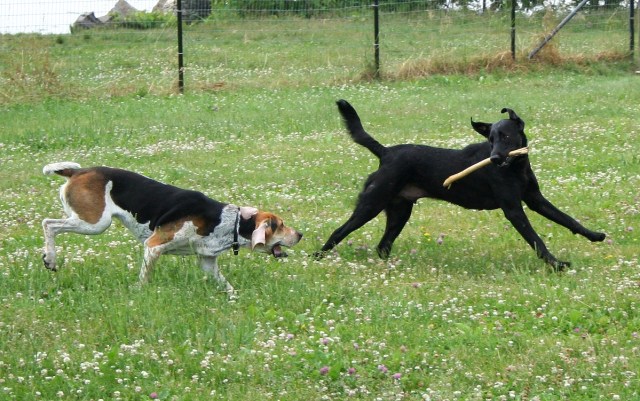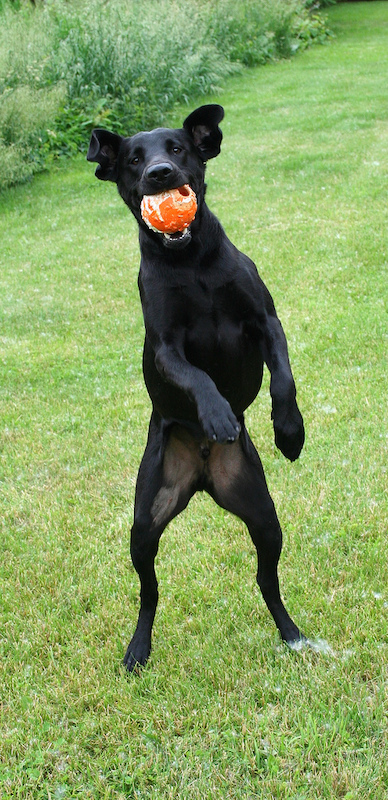Barks Blog
“I Will Never Use the Shock Collar Again!”
By Eileen Anderson

This is a story from a client of one of my professional trainer friends. Let’s call my friend “Phoebe.” My friend had met the client for some coaching for her young, exuberant dog, Raven. But it was a very long distance for the client to come. My friend received this email after she hadn’t heard from the client in a while. Some details were altered for privacy, but I’ve left the email essentially as the client wrote it because she tells the story so eloquently.
I am sharing the story because people need to know what can happen to their dogs in the unregulated profession of dog training. This is what can happen to a dog and their owner at the hand of a trainer who uses aversives.
Phoebe and I are both in awe of this email and how much Raven’s owner loves her dog. We appreciate her generosity in letting us share her cautionary tale.
Dear Phoebe,
Our last correspondence was in late April, I think. A lot has happened since then with my elderly dad’s health. As for me, I am hanging in there but a month ago I got knocked over by a friend’s dog who was here to play with Raven. The dog plowed into me from the back and down we both went. I ended up with pretty bad damage to my knee. I’m getting around now but carefully.
Now for the tragic part. Raven continued to be a handful and I couldn’t travel to see you. I was told by a friend about a local trainer who would come to the house to help. The main problems were, are, and continue to be a weak recall and difficulty controlling her if she sees a cat, another dog, a squirrel, or other things of interest. So, I met with the trainer. I adamantly refused to work with the e-collar but after the third session, I gave in. I think her words were, “well, we can train her with an e-collar or you can let her run out in the road and get hit by a car.” She promised me it would only be used on vibrate and a 1 or 2 setting. I watched a session here and was a little reassured but not totally comfortable and never comfortable enough to handle the control myself.
Anyway, in May, we needed to be gone for a long weekend. The trainer asked if Raven could stay at her home and she would work with her for that time. Raven liked and had played with her dogs before and all had been fine.
Now for the part that breaks my heart. When the trainer returned Raven on Monday afternoon, she was a different dog. She got out of the car and was cowed, would not make eye contact, her back was humped up, and her tail was between her legs. She appeared to be frightened and worried. I burst into tears. I got a lecture from the trainer on my inappropriate ways of working with Raven.
We went through the house to the back yard. She took Raven off-leash, Raven saw the cat and started to run toward it. She was given a shock that had her yelping and threw her to the ground. I was a basket case. The trainer took Raven back inside and put her on a “place” cot in the kitchen and I was told to leave her there for several hours then crate her and make her depend on me for everything–bathroom breaks, food, play, etc…
The trainer left. Raven laid on the cot and shivered. I took the e-collar off immediately and put in a box–it will never be used again!! She was afraid to get off the cot, and it was 2:00 AM before I got her to get off and come up to bed with me. It took two weeks for her to start greeting friends normally (people she knows and loves). Before that, when they would come, she would run up to my bed and hide. She is now greeting people. It was also that amount of time before she would take a treat from anyone. She would not come to the kitchen/den area (where she had been forced onto the cot) for weeks. Only last week has she started coming in and watching TV with us some nights.
Before, our custom has been to feed her then carry our dinner into the TV room on trays. Raven would climb up on the footstool or on the love seat and stay with us till time for to have a potty break before bed. But now, most of the time she looks around the door and chooses to go outside through the garage and not even come in or through the kitchen/den area (we have a doggie door that goes from den to outside). She is uncomfortable eating her dinner in front of us.
Phoebe, I am embarrassed and ashamed that I let this happen. I thought it would be safe and you know I would never let anyone hurt Raven. But the long and the short of it is that I did. I have had little contact with the trainer since. She texted a few times and asked how I was (because of the knee) and how Raven was. I told her. After her last text, I told her that I would continue to work with Raven with reward based training only. I have not heard since and I am not going to initiate any contact.
I have started from scratch again. We continue to work on basics with only rewards. Raven is consistent in the sit, wait, down, up and come without distraction. It is so easy still for me to fall into the “beat myself up” game. I am heartsick that I have let this happen but it isn’t helpful to her or me to continue to dwell on it. I must move forward. You had mentioned that I have one session left. If that is still available, I am hopeful that you can see us and advise me on how to proceed. I just wish you were closer or that I did not have the constraints of my dad and my injured knee….but I do.
First, how brave is Raven’s owner? Fear of being judged or an “I told you so” would have stopped many people from getting back in touch with their original trainer. But she did it out of love for her dog and as an expression of her own values. And she is willing to share her story to help others.
Phoebe was saddened and devastated right along with Raven’s owner, of course, and more than glad to see them again. They have had two sessions in person and are planning some remote training sessions. Raven is recovering. Let this ring loud and clear to others who may have been pushed into a wrong turn with their dogs’ training. R+ trainers want you and your dog to be happy. They are familiar with the pressures that can push you to try aversive methods like shock.
Dog Training Is an Unregulated Industry
Raven’s owner and Raven are victims of an unregulated industry. Every professional positive reinforcement-based trainer I know has stories like this. Many of the dogs they work with have fears or aggressive behaviors that have been previously installed through aversive training.
In most professions, the trainer’s behavior would be unthinkable. The list of unprofessional behaviors from this “trainer” is long.
- She hurt and terrorized Raven via the shock collar.
- She lied about her intentions, telling Raven’s owner that she would only use the collar on the two bottom settings.
- She blamed, bullied, and threatened Raven’s owner.
- She failed to be transparent and did the bulk of the punishing training out of sight of Raven’s owner.
- She exhibited ignorance about how dogs and people learn.
- She had no response when confronted with evidence of Raven’s persistent trauma.

No matter the skill level of a trainer, or whether they use the aversive only occasionally or “on a light setting,” there are always risks with aversive training. Veterinarians, credentialed behavior consultants, and professional organizations agree on these risks and recommend training with positive reinforcement. But the problem here was not only the shock collar. It is also that—in my opinion—the trainer was incompetent. This so-called “trainer” was willing to cause a dog permanent harm in order to suppress behavior, no matter the cost to the dog. She either had no knowledge of dog body language or did not care that she had left the dog with longterm trauma. Not all dogs will respond as dramatically and pitifully as Raven, although with this level of aversive use, it’s likely.
I support the movement toward regulating the dog training industry. I believe trainers should be required, at a minimum, to be transparent about their methods and the alternatives to those methods. Otherwise, stories like Raven’s will continue to be common.
Predictable Consequences of Aversive Training
Raven was terrified as a result of the shock training, and her fear got attached to the cot, to locations in her owner’s house, and to the activities of her owners. (These are textbook examples of the generalization of fear.) At the time of this writing, six weeks after the shock training, Raven still trembles in the kitchen at home.

One of the things I do in this blog is to show how dogs’ behavior correlates with the science as we know it. Usually, that’s in the context of positive reinforcement-based training. But understanding the effects of aversives is important, too. Raven’s responses to aversive training are in keeping with the science. Those responses included escape/avoidance, generalized apathy, and learned helplessness. And enduring fear. Some dogs would alternatively have developed retaliatory or redirected aggression.
Telling an anecdote about one dog and one trainer doesn’t in itself “prove” that aversives have fallout. But we don’t need it to. That fact is already amply supported in the science. What telling the story does is to show you what those observations of textbook fallout look like in real life. I hear or read several of these stories per week. I hear about the doodle with nervous diarrhea and colitis—he wears two shock collars because his owners have electronic fences both outside and inside the house. I hear about the dog who bit his new owner after receiving a painful “correction” at the direction of a self-proclaimed trainer. I see with my own eyes the terrier who has been so mistreated on the agility field that he cowers at the start line. My trainer friends are frequently the cleanup crew when a dog has been reduced to a pitiful wreck by an aversive trainer. It takes a toll on them.
The false dichotomy presented by the aversive trainer—well, we can train her with an e-collar or you can let her run out in the road and get hit by a car—is unfortunately a fairly common tactic. Aversive trainers will say the dog will run into traffic and die, or become unmanageable, or bite someone and get euthanized—unless aversive methods are used. But this is not what the science tells us. In fact, there is evidence that behavioral euthanasia correlates with aversive training methods. The very opposite of what the aversive trainers claim.
Helping the Dogs and Humans Recover
I can relate to what happened to Raven’s owner. I once had a dog whom I desperately loved, but who was wreaking havoc with my life and was a danger to my smaller dog. I used aversives (a prong collar and forceful handling) because those were the solutions offered to me by the people who claimed authority about dog behavior and training. My situation felt untenable, and that was the only way out that I saw. I am so sorry, just as Raven’s owner is. And we are both learning better ways.
Raven’s owner was brave. She came back to Phoebe and told her the whole truth of what happened. Use of aversives has fallout on owners, too. We don’t know how many are too embarrassed to seek help after their dog has been abused in the name of training, much less to describe the sad situation so thoroughly. Or how many run out of money for training. So kudos go to Raven’s owner for protecting Raven from further abuse from the so-called trainer. Raven’s original problems of not coming when called and over-arousal in the presence of other animals are straightforward to address, and Phoebe is helping this sweet dog and loving, honest owner to go forward.
Copyright 2019 Eileen Anderson

Reference
Siracusa, C., Provoost, L., & Reisner, I. R. (2017). Dog-and owner-related risk factors for consideration of euthanasia or rehoming before a referral behavioral consultation and for euthanizing or rehoming the dog after the consultation. Journal of Veterinary Behavior, 22, 46-56.
Photo Credits
The photo of my rat terrier, Cricket, on the blue mat belongs to me.
The three photos featuring the black lab are by Peter Wadsworth and were uploaded from Flickr to Wikimedia Commons according to the licenses of the two sites. They are shared under the Creative Commons Attribution 2.0 Generic license. The dog in the photos is not connected with the story in this post in any way.
About the Author
Passionate amateur dog trainer, writer, and learning theory geek. See more at https://eileenanddogs.com.
